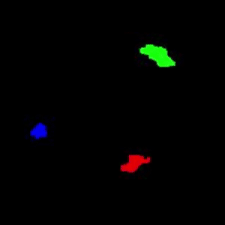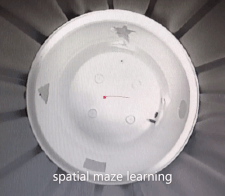Services | Overview
The Animal Behavior & Physiology Core (AB&P) provides and maintains unique and modular platforms that enable multi-layered, comprehensive neurodevelopmental disease model phenotyping. The available assays provide measures of target engagement by pharmacological agents and enable necessary preclinical PK/PD studies once a therapeutic is deployed in any of the available models.
View a full list of behavioral and physiological assays.
Housing
- One dedicated room with 9 rotating towers that allocate up to 900 cages total for standard care. Each cage can house up to 5 mice and contains highly absorbent bedding, specialized nesting material and tunnels or shelters.
- Reverse light/dark cycle room can house up to 300 cages (lights off from 10:00am to 10:00pm).
- Enriched housing is available with wide range of manipulations of sensory, motor and social environment, such as running wheels, labyrinths, toys and increased social settings, with the ability to significantly impact the trajectory of brain development.
- Housing in special environment to manipulate the visual experience (dark-rearing) or sound exposure (white noise, selective frequency exposure, music exposure).
Behavioral assays
The AB&P allows precise and reproducible measurements of behavioral phenotypes of standard strains as well as of transgenic, knockout, genetically modified animal models, and rodent models of early life brain injury.
- Neurobehavioral phenotyping with the SHIRPA test
- Gait analysis is measured on a treadmill by video analysis of footprints using Digigait
- Spatial cognition assessment through Morris water maze and Y-maze tests
- Social recognition is evaluated using the 3-chamber test
- Working memory and cognitive flexibility are assessed using novel object/subject recognition, Y maze and water T maze
- Cognitive age-dependent flexibility is tested using foraging task
- 12 operant touchscreens test working memory (2 choice discrimination), flexibility (reversal of previous rule learning), attention (5 choice serial reaction time) and motivation (progressive ratio)
- Pain sensitivity to mechanical, heat and cold stimuli are tested measuring a wide range of voluntary reactions

Footprint analysis

Physiological assays
The physiology arm of the Core functions in parallel to the behavioral arm, providing a wealth of data to supplement your experiments. In some cases, physiological data can be acquired during behavioral assays.

Sample seizure – representative EEG showing baseline, seizure and post-ictal slowing
- Multi-cage wireless video EEG and related bio-signals such as electrocardiography, core temperature, electromyography and actigraphy, for the identification of epileptic seizures, sleep stages, and effects of drugs, injury, genetic manipulation or other factors on a range of brain and body rhythms.
- Wired EEG via mice head connection (if mice are too small or young for implants of the telemeters).
- The preclinical transcranial magnetic stimulation (TMS) enables measures of cortical excitability and plasticity that are valuable as metrics of pharmaceutical target engagement, and also enables deeper electrophysiological phenotyping of rodent disease CNS models.
- In vivo calcium imaging by multifiber photometry coupled with behavioral analysis such as operant behavior, social or anxiety tests;
- Whole-body plethysmography system for measuring breathing function in conscious, unrestrained mice;
- ECGenie system for measuring the electrocardiogram of conscious, unrestrained mice.
- In vivo microdialysis for sampling neurochemicals and other constituents of the peripheral and central nervous systems in a conscious, freely moving rodent.
- Open flow microperfusion (OFM) provides dynamic substance profiles and absolute substance quantification in the investigated target tissues and can currently be performed in brain and skin/adipose tissue, with anesthetized or awake and behaving animals.
The combination of traditional microdialysis and OFM allows core users to measure analytes ranging from small molecules to proteins and beyond to extracellular vesicles and infiltrating cells. This capability aids our users in understanding behavior at the neurochemical level.
- Using HPLC and UV-vis, florescent and electrochemical detectors, we can isolate and measure compounds and proteins of interest.
- In addition to the capacity for recording behavioral and electrophysiologic data from any mouse and rat strain, the AB&P Core offers users access to expertise in several epilepsy and traumatic brain injury models as follows:
- Acute chemoconvulsant: pentylenetetrazol, kainate, pilocarpine.
- Acquired epilepsy: fluid percussion traumatic brain injury, perinatal hypoxia/ischemia (by carotid ligation), kainite or pilocarpine status epilepticus (separate from acute chemoconvulsant models)
- Closed head injury concussion model: by single or repeated weight drop
Other services
- Compound administration by intravenous, intraperitoneal, sub-cutaneous, oral, intra-muscular, intraventricular and enteric routes.
- Collection of plasma and other body fluids as well as tissue samples for pharmacokinetic/pharmacodynamic measures and toxicology screens.
- Stereotaxic surgery expertise to implant EEG/EMG electrodes, guide cannulae for subsequent drug administration, direct cranial injections and cranial windows.
- Data analysis and metrics extraction either from data collected in the AB&P or from data sets provided by outside clients.
Pricing
For pricing, please contact either Alexander Rotenberg, MD, PhD, or Michaela Fagiolini, PhD.
